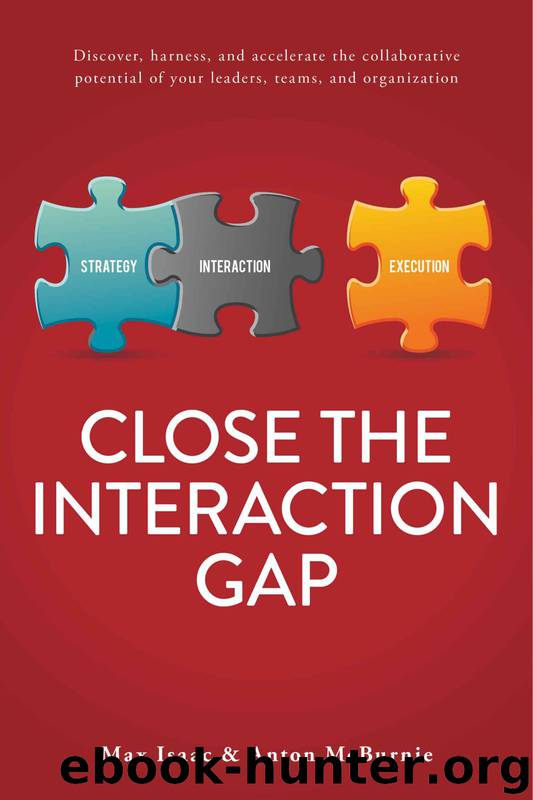Close the Interaction Gap: Discover, harness, and accelerate the collaborative potential of your leaders, teams, and organization by Isaac Max & McBurnie Anton

Author:Isaac, Max & McBurnie, Anton [Isaac, Max]
Language: eng
Format: epub
Tags: Management, teamwork, leadership
Publisher: Bridge Publishing
Published: 2015-02-09T22:00:00+00:00
Staying Aligned: Walking the Talk Takes More Talking
In many organizations we visit, it’s clear that there is a predominantly one-and-done attitude towards alignment: do it once at the beginning and you’re set to go. The fallacy of that attitude should be clear by now. As we noted above, it’s impossible to predict all the ways in which people and groups can be misaligned. Also, it’s clear that even once-aligned people or groups will drift out of alignment, sometimes quite rapidly. Checking alignment cannot be a one-time event; it has to be monitored and checked with a greater frequency than is taking place now in most organizations.
That switch in attitude brings about dramatic shifts in behavior. Once people realize they need to assume that misalignment is far more common than alignment, they feel much more obliged and interested in being more communicative. There’s no magic to checking alignment; it really is as simple as doing more talking. By that, we don’t mean just increasing the number of words you use. We mean making the effort to check with people, again and again and again as needed to stay aligned (hence the labeling of alignment as a “mundane” topic in this book). This can be as simple as revisiting a decision, goal, ground rule, etc., that your group has crafted. For example, periodically ask your team or work groups, “Do we still agree on ______?” or “Has anything changed to affect what we want to do? Is the guideline we established working for all of us?”
This linking of communication and alignment will probably not be surprising. People who tell us about painful struggles they’ve had with past teams and misunderstandings that led to poor outcomes—or at least that made the work much harder than it needed to be—almost always frame it as a communication problem.
The nature of the communication has to be appropriate as well. Later in this book, we’ll talk about a cross-functional team that really struggled to get work done. The sub-teams very rarely communicated with each other, and when they did it was in VERY detailed status reports (the kind that make your eyes glaze over when you’re just 2 pages into a 40-page document). Now, the sub-teams have established direct connections between their members and status reports are both MUCH shorter and timelier—something along the lines of a text that says “FYI—the shipment will be 3 days late.” Brief, frequent communications like this has prevented innumerable headaches for this company. (For details, see chap. 11).
Staying aligned definitely falls into the mundane category . . . but it can spill over into the tricky arena if a misalignment goes unrecognized for a long period of time. The two sides of the product development team featured at the start of this book, for example, were so misaligned around the details of what the goal of “quality” really meant that they spent the better part of two years in conflict with each other. There was resentment on both sides, hard feelings pent up from perceived slights and outright insults.
Download
This site does not store any files on its server. We only index and link to content provided by other sites. Please contact the content providers to delete copyright contents if any and email us, we'll remove relevant links or contents immediately.
Hit Refresh by Satya Nadella(9040)
The Compound Effect by Darren Hardy(8812)
Change Your Questions, Change Your Life by Marilee Adams(7636)
Nudge - Improving Decisions about Health, Wealth, and Happiness by Thaler Sunstein(7619)
The Black Swan by Nassim Nicholas Taleb(7011)
Deep Work by Cal Newport(6881)
Daring Greatly by Brene Brown(6449)
Rich Dad Poor Dad by Robert T. Kiyosaki(6410)
Principles: Life and Work by Ray Dalio(6219)
Playing to Win_ How Strategy Really Works by A.G. Lafley & Roger L. Martin(5928)
Man-made Catastrophes and Risk Information Concealment by Dmitry Chernov & Didier Sornette(5922)
Digital Minimalism by Cal Newport;(5665)
Big Magic: Creative Living Beyond Fear by Elizabeth Gilbert(5615)
The Myth of the Strong Leader by Archie Brown(5427)
The Slight Edge by Jeff Olson(5350)
Discipline Equals Freedom by Jocko Willink(5286)
The Motivation Myth by Jeff Haden(5157)
Stone's Rules by Roger Stone(5027)
The Laws of Human Nature by Robert Greene(5001)
